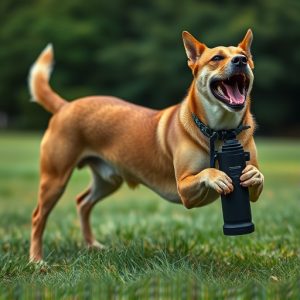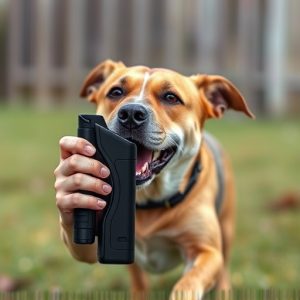Professional Animal Control Spray: Safety, Efficacy, and Eye Care
Animal control pepper spray, using capsaicin from chili peppers, is a powerful deterrent for aggress…….
Animal control pepper spray, using capsaicin from chili peppers, is a powerful deterrent for aggressive animals but requires careful handling. Improper use can cause adverse effects, especially in dogs, with eye irritation requiring immediate rinsing with water for 15 minutes and veterinary care if irritation persists. Safety precautions, including protective gear and proper storage, are crucial to prevent accidental exposure or abuse. Professional-strength animal control sprays offer more effective solutions for targeted issues like removing pepper spray from dog eyes, but legal considerations and safety guidelines must be followed strictly.
“Animal control spray, especially professional-strength varieties, has emerged as a powerful tool in managing aggressive animal behavior. This article delves into the intricacies of this potent solution, focusing on its composition and safety, the impact on dogs, and immediate care protocols. We explore effective methods to remove pepper spray from dog eyes, a crucial skill for pet owners and professionals alike. Additionally, we compare professional strengths with home remedies, discuss necessary precautions, and provide legal insights, ensuring responsible and safe usage.”
- Understanding Animal Control Pepper Spray: Composition and Safety
- How Pepper Spray Affects Dogs: Symptoms and Immediate Care
- Effective Methods to Remove Pepper Spray from Dog Eyes
- Professional Strength vs. Home Remedies: Which is More Effective?
- Precautions and Legal Considerations for Using Animal Control Spray
Understanding Animal Control Pepper Spray: Composition and Safety
Animal control pepper spray, also known as capsaicin spray, is a powerful tool used to deter and subdue aggressive animals. Its primary active ingredient is capsaicin, derived from chili peppers. This compound stimulates nerve endings in the eyes, nose, and throat, causing temporary disorientation and pain. The composition typically includes water, capsaicin oil, and various additives for stability and effectiveness. When used professionally, it’s crucial to understand its safety profile.
While effective, pepper spray can cause adverse effects if not handled properly. Removing pepper spray from a dog’s eyes, for instance, requires immediate action. It’s essential to rinse the affected area with plenty of water for at least 15 minutes and seek veterinary care if irritation persists. Safety precautions should be followed by both users and animals, including wearing protective gear and ensuring proper storage to avoid accidental exposure or abuse.
How Pepper Spray Affects Dogs: Symptoms and Immediate Care
Pepper spray, a common self-defense tool, can have severe effects on dogs if they come into contact with it. When a dog’s eyes are exposed to pepper spray, it triggers an intense irritation and inflammatory response due to the capsaicin, the active ingredient. This can lead to immediate symptoms such as excessive tearing, squinting, redness, and swelling of the eyes. The dog may also exhibit signs of discomfort, including pawing at its face, whining, or even temporary blindness.
If your dog comes into contact with pepper spray, it’s crucial to act swiftly. Immediately rinse the affected area with large amounts of clean water for at least 15 minutes to dilute and flush out the irritant. Remove any pepper spray residue from their fur, especially around the eyes and nose. If irritation persists or worsens, seek veterinary care promptly. A vet can provide further treatment options like antihistamines or eye drops to alleviate discomfort and prevent potential damage. Remember, quick action is essential to ensure your dog’s safety and well-being after exposure to pepper spray.
Effective Methods to Remove Pepper Spray from Dog Eyes
When a dog comes into contact with animal control spray, it can cause severe irritation and discomfort due to its highly potent capsaicin content. Removing the pepper spray from their eyes as quickly as possible is crucial to mitigating the effects. Start by rinsing the dog’s face gently with plenty of clean water, ensuring the stream is warm but not hot, which can further irritate the eyes. This initial rinse helps dilute and wash away some of the spray residue.
After the initial rinse, use a soft, damp cloth or eye pad to continue cleaning the affected area. Gently wipe around the eyes, removing any visible pepper spray particles. Be careful not to rub, as this could spread the irritant further. For more persistent residue, consider using a mild, dog-safe detergent or baby shampoo to create a soapy solution. Apply it to a clean cloth and gently dab at the eyes, following with another thorough rinse. Regular cleaning and hydration can help soothe irritated eyes and prevent any long-term damage.
Professional Strength vs. Home Remedies: Which is More Effective?
When dealing with unwanted animal behavior, many homeowners turn to pepper spray as a quick fix, particularly for removing pepper spray from dog eyes. While home remedies like this can offer temporary relief, professional-strength animal control sprays are often a more effective and long-lasting solution. These specialized products are designed to address specific animal behaviors and are formulated with active ingredients that disrupt the animal’s sensory systems without causing severe harm or discomfort.
Professional-grade sprays typically contain higher concentrations of capsaicin, the active compound in chili peppers, which makes them more potent. This increased strength ensures a quicker response and longer duration of effect, making it ideal for persistent issues like repeated intrusions from stray animals or aggressive behavior from pets. Moreover, these products often come with detailed instructions and safety guidelines, ensuring users can apply them correctly and safely.
Precautions and Legal Considerations for Using Animal Control Spray
When using professional-strength animal control spray, it’s crucial to be aware of several precautions and legal considerations. Always wear protective gear, including gloves and goggles, to avoid direct contact with the spray. Ensure proper ventilation to minimize inhalation risks for both you and the animals involved. Keep in mind that these sprays are designed for specific situations, such as deterring aggressive dogs or managing wild animal infestations.
Legally, the use of animal control spray varies by region. Familiarize yourself with local laws and regulations before deploying any spray. For instance, some areas have strict guidelines on when and where pepper spray (a common active ingredient) can be used, especially around domestic animals like dogs. Remember that removing pepper spray from a dog’s eyes requires immediate action, including thorough rinsing with water and seeking veterinary care if irritation persists. Always prioritize safety and follow best practices to avoid legal repercussions and ensure the well-being of both humans and animals.
When it comes to dealing with aggressive animals, professional-strength animal control spray can be a powerful tool. While its use requires careful consideration of safety and legal aspects, understanding its composition and effectiveness is crucial for responsible application. In the event of exposure, knowing how to promptly remove pepper spray from a dog’s eyes is essential for minimizing discomfort and potential long-term damage. Through proper precautions and informed decision-making, individuals can effectively navigate the use of animal control spray while ensuring the well-being of both humans and animals. Remember, always opt for professional-grade products and follow recommended removal methods, such as using specialized eye wash solutions, to quickly and safely address any incidents involving pepper spray and dogs.


